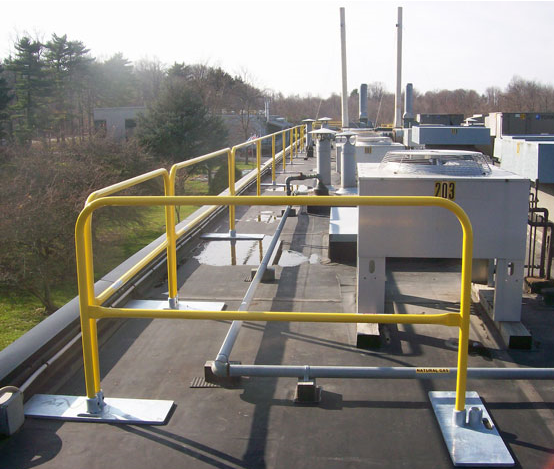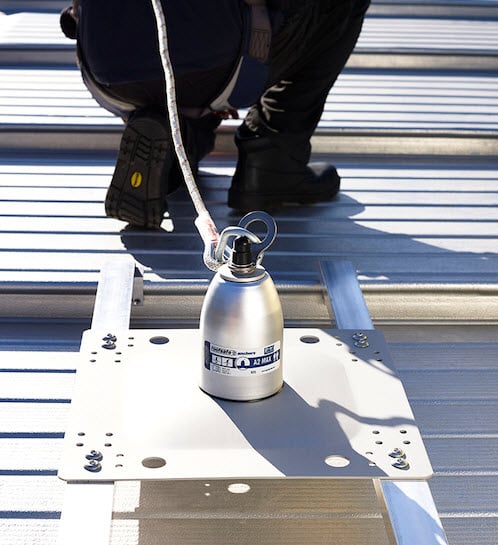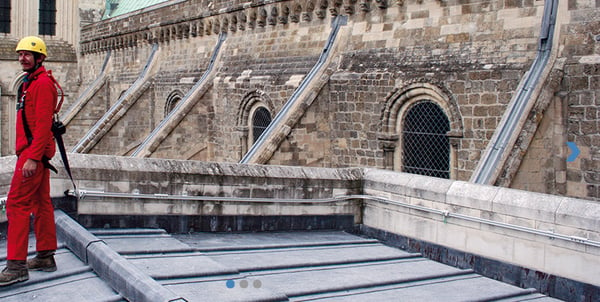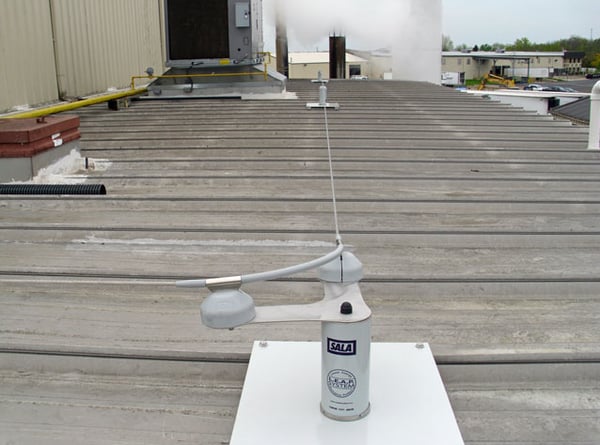The rooftop maintenance season is now in full swing. In the eyes of OSHA, your building’s roof is a raised work platform of four feet or more, and as such, all of the unprotected leading edges pose fall hazards. That said, every rooftop is unique. The “ideal” rooftop fall protection system installed next door may not suit your specific needs due to differing maintenance requirements. This post offers a brief introduction to common rooftop fall protection solutions and their many uses.
Guardrail
When maintenance is required over large sections of the roof, freestanding or non-penetrating perimeter guardrail is often one of the simplest and cost-effective solutions. One of the advantages to pre-engineered portable guardrail is ease of installation: installers lay out a base plate pattern, insert the railing in the receivers, and secure with simple set screws. Because the base plates rest on top of the roofing material, the installation is completed without penetrations, which minimizes the risk of leaks.
Rooftop guardrail systems are also easy to use. There is no need to wear a body harness or tie-off, and maintenance staff can easily reach any point on the rooftop. Despite these facts, there are some popular misconceptions about portable guardrail. Some of our clients worry that the base plates add too much weight to the roof. Although this concern may seem well-founded, our base plates are up to 50% lighter than the competition, weighing 59 pounds. Another common misconception is that portable guardrail systems are not well-suited for permanent applications. It is true that free-standing guardrail is ideal for temporary fall protection applications, but LORGUARD™ guardrail can also withstand sustained 150 MPH winds (standard hurricane loading). For flat roof applications where ground level sight lines are not a consideration, a free-standing guardrail system is often your best option.
Single Point Anchors
Unlike guardrail systems, single point anchors are designed for compact, clearly defined work areas. The key to single point anchor use is carefully delineating a safe working zone to minimize swing fall risks. Thinner metal roofs and steeply pitched applications require the use of a rigid post anchor that attaches to structural members beneath the roof. For low slope applications, we can install a tip-over or shock absorbing single point anchor without making large penetrations, as shown below:
Although the image above shows a tip over post mounted on a standing seam metal roof, these anchors are easily installed on rubber and plastic membranes as well as bituminous, built-up, and ballast style roofs. OSHA regulations specify non-engineered single point anchors must be rated at 5,000 for one user or 10,000lbs for two users. For engineered single point anchors by a qualified person, the standard is two times the applied load in the event of a fall. Users must have their own designated attachment point, in other words, no two individuals may share the same designated attachment point.
Low Profile Rigid Track Fall Protection Systems
Easily concealed from ground level, track systems offer workers a greater range of motion than single point anchors. In addition to these characteristics, a rigid track system minimizes deflection in the event of a fall. Although the name suggests a rail running in a linear, straight line fashion, it is possible to accommodate curves and sharp corners in path to follow the contours of the building as shown in the picture below:
Horizontal Lifelines
Next to guardrail, horizontal lifelines are probably the most commonly recognized form of rooftop fall protection in the eyes of safety managers. In simplest terms, a HLL consists of a steel cable that is threaded through a series of rigid or tip-over anchors. Appropriate for a wide range of roof pitch ratings, horizontal lifelines offer a better range of motion than single point anchors and these systems are less visible from ground level than guardrail.
Despite the simplicity of appearance, horizontal lifelines are highly engineered fall protection systems. To ensure compliance, an HLL must meet the following OSHA standards:
Horizontal Lifelines
1926.502(d)(8)
Horizontal lifelines shall be designed, installed, and used, under the supervision of a qualified person, as part of a complete personal fall arrest system, which maintains a safety factor of at least two.
Personal Fall Arrest Systems
1926.502(d)(16)
Personal fall arrest systems, when stopping a fall, shall:
1926.502(d)(16)(ii)
limit maximum arresting force on an employee to 1,800 pounds (8 kN) when used with a body harness;
1926.502(d)(16)(iii)
be rigged such that an employee can neither free fall more than 6 feet (1.8 m), nor contact any lower level;
1926.502(d)(16)(iv)
bring an employee to a complete stop and limit maximum deceleration distance an employee travels to 3.5 feet (1.07 m); and,
1926.502(d)(16)(v)
have sufficient strength to withstand twice the potential impact energy of an employee free falling a distance of 6 feet (1.8 m), or the free fall distance permitted by the system, whichever is less.
Parting Thoughts
Although most rooftop fall protection scenarios look similar to the untrained eye, each application is unique. By partnering with a qualified safety engineer, you can ensure the fall protection system meets your specific needs and budget while ensuring worker safety and OSHA compliance. What’s more, your fall protection company can explain a host of installation options that require minimal or no roof penetration. To learn more rooftop fall protection options, or to discuss your specific application, contact Diversified Fall Protection for further assistance.





